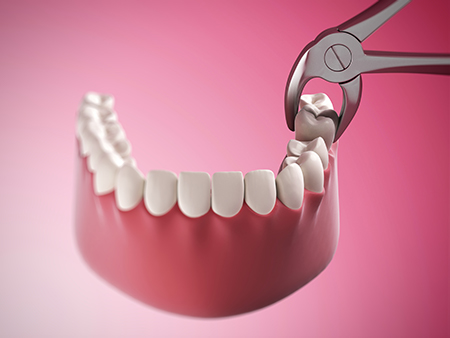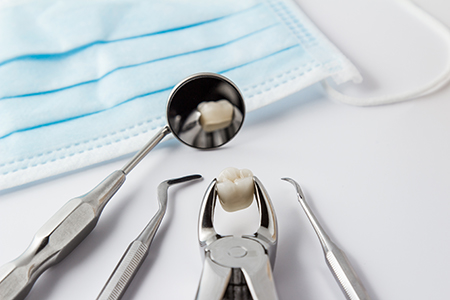
Our Office
Visit Us Online

At the office of Towne Dental & Orthodontics, our primary objective is to protect your long-term oral health. While conserving natural teeth is always the first choice, there are situations where removing a tooth is the safest and most responsible option. Extractions can stop the spread of infection, prevent damage to neighboring teeth, and eliminate sources of chronic pain or dysfunction.
We approach every extraction with a clear plan: evaluate the cause, outline the procedure, and explain next steps for healing and replacement if needed. Our team carefully reviews your medical history, current medications, and any risk factors that might affect the procedure. That assessment helps us choose the most appropriate technique and support a smooth recovery.
Understanding why a tooth needs to come out helps patients make informed decisions. Below are common scenarios that lead our clinicians to recommend extraction, each described in plain terms so you know what to expect and why timely care matters.
An over-retained primary (baby) tooth
Sometimes a baby tooth fails to loosen and fall out as the permanent tooth is ready to erupt. When the primary tooth retains its roots or becomes fused to the jawbone, it can block the normal path of the adult tooth and disturb how the bite develops. Removing an over-retained tooth can help guide growth and avoid more complicated orthodontic problems later.
A permanent tooth that cannot be restored
Decay starts small but can progress through enamel into deeper structures of the tooth if left untreated. When a tooth is compromised beyond repair — including extensive loss of structure or damage to the nerve that can’t be resolved — extraction becomes the most predictable way to remove ongoing infection and protect your overall health.
Severe fracture or structural damage
Teeth can fracture in many ways. If a crack extends below the gum line, splits the root, or otherwise leaves too little sound tooth to support a restoration, extracting the tooth may be the safest path. Removing a severely damaged tooth also prevents persistent pain and reduces the risk of infection.
Advanced periodontal (gum) disease
Periodontal disease attacks the supporting tissues and bone around teeth. In advanced stages, teeth lose stability and may not be salvageable. Extracting teeth that have been severely compromised by gum disease can stop further bone loss and make it easier to restore oral health through other treatments.
Impacted or problematic wisdom teeth
Third molars frequently lack room to erupt properly and can become impacted, decay-prone, or a source of crowding and infection. Removing troublesome wisdom teeth before they cause damage to adjacent teeth and tissues is a common preventive step for many young adults.
Teeth removed for orthodontic alignment
When jaw size and tooth size are mismatched, selective extractions can create the space needed to achieve a healthy, functional bite with orthodontic treatment. In those cases, removing a tooth is done strategically to improve alignment and long-term oral function.

Before any extraction, we perform a thorough evaluation that includes a review of your medical history, an oral exam, and targeted x-rays when necessary. These steps let us determine whether a simple removal is possible or if a more involved surgical approach will be required. We’ll also discuss anesthesia choices so you know how pain and anxiety will be managed.
It’s important to tell us about any medications you take and any medical conditions you have. Certain health issues or medications can affect bleeding and healing or require coordination with your physician prior to treatment. If precautions are needed, we will clearly explain them and make any necessary arrangements so your care proceeds safely.
Our aim is to make the day of the procedure as calm and predictable as possible. We will explain the steps, answer your questions, and review aftercare instructions before you leave. If a tooth replacement is likely, we’ll outline the options and timing so you can plan for the next phase of restoring comfort and function.
We use modern diagnostic tools such as digital radiography to map tooth position and root anatomy. Based on that information, extractions are generally classified as straightforward or surgical, and the technique is chosen to provide the best outcome with the least trauma.
Simple extractions are appropriate when the tooth sits fully visible in the mouth and the roots are uncomplicated. After numbing the area with local anesthetic, the clinician loosens the tooth and removes it with specialized instruments. The process is typically quick and designed to minimize discomfort and tissue trauma.
Patients who feel anxious can ask about additional calming measures. We offer options to help reduce stress and make the visit more comfortable while maintaining safety and predictable results.
Surgical extractions are used for teeth that are broken at the gum line, impacted, ankylosed to the bone, or otherwise inaccessible for a simple removal. This procedure may involve a small incision and careful removal of bone to access and extract the tooth. In some cases we refer to an oral and maxillofacial surgeon who specializes in these more complex situations.
Local anesthesia is used in all cases, and additional sedation options can be arranged based on the complexity of the procedure and the patient’s needs. We will discuss the plan, possible referrals, and the expected recovery timeline before scheduling surgery.

Healing after an extraction varies by person and by the complexity of the removal. Our clinicians provide tailored post-operative instructions based on your individual case, including activity restrictions, pain control, and follow-up appointments. Following these recommendations helps minimize complications and supports efficient tissue repair.
Expect some bleeding, swelling, and mild discomfort in the first 24–72 hours. Most symptoms improve steadily with simple home care measures, rest, and the appropriate use of prescribed or over-the-counter medications. We will advise you about when to resume normal eating, exercise, and oral hygiene routines.
If your case involves a complex extraction, infection, or medical considerations, we may request closer monitoring and additional follow-up. In all situations, prompt contact with our team is encouraged if unusual symptoms appear so they can be addressed early.
Maintain gentle pressure with gauze
Immediately after the extraction, bite down gently on the supplied gauze to encourage clot formation. Change the gauze according to instructions, and allow firm but comfortable pressure to control bleeding. Minor oozing for up to 24 hours is common, but continuous heavy bleeding should be reported to our office.
Protect numb tissues until sensation returns
Local anesthesia temporarily numbs the lip, tongue, and cheek. Avoid chewing or touching the area until normal feeling returns to prevent accidental injury or biting of soft tissues.
Take any prescribed medications as directed
Antibiotics:
If antibiotics are prescribed, complete the full course to reduce the risk of infection and support predictable healing.
Pain relief:
Start pain medication before the numbness fully wears off if recommended. Use over-the-counter or prescription analgesics exactly as instructed to keep discomfort manageable.
Avoid actions that disturb the clot
Do not rinse vigorously, spit forcefully, use a straw, or perform heavy sucking actions during the first day or two. These behaviors can dislodge the blood clot and delay healing.
Use ice for swelling control
Apply an ice pack to the outside of the face in short intervals (for example, 10 minutes on, 10 minutes off) during the first 24 hours to reduce swelling and discomfort.
Refrain from smoking
Smoking interferes with clot formation and significantly increases the risk of delayed healing and complications. Avoid tobacco use for at least a week after the extraction, or longer as advised.
Choose gentle, nourishing foods
Start with cool, soft foods and liquids. Avoid very hot, spicy, or highly acidic items for the first few days, and progress to firmer foods as comfort allows. Stay hydrated to support recovery.
Keep your mouth clean, gently
Brush carefully around the extraction area and use a mild lukewarm saltwater rinse after the first 24 hours to keep the site clean. Avoid vigorous rinsing and try to let liquids fall from your mouth rather than spitting forcefully.
Attend your follow-up appointment
If sutures were placed or your case needs monitoring, be sure to keep your scheduled follow-up visit so we can assess healing and remove stitches if necessary.
If you notice increasing pain, heavy bleeding, persistent swelling, a bad taste or odor, or any other concerning symptom, contact our office promptly so we can evaluate and provide appropriate care.

Removing a tooth sometimes leaves a gap that affects chewing, speech, and the neighboring teeth over time. We will discuss replacement choices when appropriate — including dental implants, fixed bridges, and removable prosthetics — and explain how each option fits with your oral health goals, timeline, and the condition of surrounding tissues.
Dental implants are often recommended when the goal is to replace a single tooth with a long-term, natural-feeling solution that helps preserve bone. Bridges can restore function and aesthetics when adjacent teeth provide suitable support. Removable dentures remain a reliable option for replacing multiple teeth or when surgical approaches are not ideal.
Timing matters: sometimes an immediate or delayed replacement is advised depending on the extraction site, infection status, and bone volume. We’ll review the pros and cons of each route and help you choose a plan that balances predictability, durability, and the least disruption to daily life.
When a tooth is removed as part of orthodontic treatment, the focus shifts to achieving the planned alignment and bite. In those cases, restorative replacement may come later, once orthodontic goals are met.
When you need an extraction, trust and clear communication are essential. Our team focuses on evidence-based techniques, careful planning, and attentive aftercare to promote predictable outcomes. We make it a priority to describe each step, potential risks, and realistic expectations so you feel informed and confident about your treatment.
Every patient is different, and we tailor our approach to your medical history, comfort needs, and long-term dental objectives. If a surgical referral is the safest option, we coordinate that process and remain involved to ensure continuity of care and optimal healing.
If you have questions about tooth removal, healing, or replacement options, or if you’re experiencing a dental problem that may require extraction, please contact us for more information. Our team is ready to explain the choices and help you plan the best path forward for your smile.
The most common reasons for tooth loss include advanced periodontal disease, extensive tooth decay, and facial trauma. According to statistics, gum disease is responsible for close to 70% of tooth loss in adults. Although less frequent than the preceding three reasons, it should also be noted that specific diseases, drugs, smoking, and poor nutrition contribute to the risk of tooth loss.
The Centers for Disease Control and Prevention report that in the United States, an average of 12 teeth (including the wisdom teeth) are lost by the age of 50. Also, 26% of adults between 65 and 74 years of age have lost all their teeth.
Every patient and every situation is different. However, when a tooth and the surrounding tissues are numbed with a local anesthetic, you should only expect to feel a bit of pressure, but no pain as the tooth is being loosened from the surrounding tissues and extracted. For patients who are apprehensive and for some surgical extractions, our office will discuss our options in dental sedation to provide further relaxation and reduce any sense of discomfort.
While it's normal to feel some tenderness and swelling following an extraction, the degree of these sensations can vary. It mostly depends on the complexity of the extraction and the body's response to the procedure. We'll recommend or prescribe the appropriate pain medication to help ensure your comfort and give you specific instructions for maximum effectiveness and safety.
Typically, the recovery period following a simple extraction is shorter than a surgical extraction. However, a patient's overall health, habits, the size and location of the tooth, and other variables can influence recovery and healing. To speed up the recovery and avoid any complications, patients must follow the given at-home instructions diligently. We'll carefully review what to expect following your procedure and go over your post-op instructions.
Smoking interferes with blood clot formation, which is an essential first step in the healing process. Blood clot formation not only provides a protective layer to cover the underlying exposed bone and nerve endings, but it also supports the growth of new tissue. Cigarette smoke also contains chemical toxins that can disrupt the healing process and lead to problems such as continued inflammation, infection, or dry socket.
In a very small percentage of cases, a condition known as dry socket can develop in the aftermath of a dental extraction. This painful condition can arise when the blood clot in the extraction site doesn't form properly or gets dislodged. With dry socket, you may experience throbbing pain and symptoms such as bad breath and an unpleasant taste in your mouth. As skilled providers of care, our office will provide immediate treatment to alleviate your discomfort and promote healing.
The last teeth in your mouth to develop, wisdom teeth often do not have enough room to fully erupt or may be positioned in the wrong direction. These issues can affect your dental health as well as overall wellbeing. While some individuals never develop all their wisdom teeth, and a few have sufficient space for them, there are many people with partially or fully impacted third molars. Our office will monitor the development, position, and health of your wisdom teeth and will advise you if and when extractions are indicated.
After a tooth is removed, bone-grafting material is sometimes placed in the socket to promote healing and encourage new bone development. This procedure is often performed to support the eventual and successful placement of a dental implant.
At the office of Towne Dental & Orthodontics, we strive to make dental care affordable and accessible. Depending on the type or complexity of the extraction and other variables, the cost of the procedure can vary. Based on our diagnostic findings, our office will inform you of the healthiest choices in care, explain the fees, discuss insurance coverage, and explain your payment options.
Many dental plans offer some level of coverage for tooth extractions. We'll advise you if your plan covers the full cost of the procedure and if there is any out-of-pocket expense. Our business office will work with you to maximize your insurance benefits as much as possible while helping you minimize any out-of-pocket expenses.
There are several clinical reasons a dentist may advise removing a tooth, including severe decay, extensive fracture, advanced periodontal disease, or problematic wisdom teeth that are impacted or creating crowding. Extractions can stop the spread of infection, remove a persistent source of pain, and protect adjacent teeth and supporting bone from further damage. Each recommendation is based on a careful assessment of the tooth's restorability and the overall impact on oral health.
Before recommending removal, clinicians evaluate medical history, current medications, and diagnostic images to ensure the choice is safe and appropriate. When possible, conservative treatments are preferred, and extraction is presented as the most predictable option when preservation is unlikely to succeed. Your dentist will explain alternatives and the expected benefits of extraction as part of shared decision-making.
A simple extraction is used when a tooth is fully erupted and accessible in the mouth; after effective local anesthesia the dentist loosens the tooth with elevators and removes it with forceps. This approach typically involves minimal trauma to soft tissue and short procedure time, and it is appropriate when roots are uncomplicated. Recovery from a simple extraction is often quicker and easier to manage at home.
Surgical extraction is chosen for teeth that are broken at the gum line, impacted, fused to bone, or otherwise not retrievable by forceps alone. The clinician may need to make a small incision, remove a bit of bone, or section the tooth to extract it safely, and sutures are sometimes placed. Complex cases may be referred to an oral and maxillofacial surgeon for specialized care and appropriate sedation options.
Pain control for extractions begins with local anesthesia to numb the area so you feel little to no pain during the procedure. Topical anesthetic may be used before injections to reduce discomfort, and the team will confirm you are comfortable before proceeding. For most patients local anesthesia provides reliable pain control for simple and many surgical extractions.
If anxiety or the complexity of the case warrants additional support, options such as nitrous oxide, oral sedation, or referral for deeper sedation can be discussed. The dental team will review medical history and any medications to select safe sedation strategies and explain recovery expectations. Clear instructions about post-procedure pain management are provided so you can keep discomfort at a manageable level as healing begins.
Preparation begins with a thorough review of your medical history, current medications, and any allergies so the clinician can plan safely. If you take blood-thinning medications or have medical conditions that affect healing, coordination with your physician may be recommended before the procedure. Bring a list of medications and be prepared to discuss any past reactions to anesthesia or sedation.
If you will receive sedation, follow fasting instructions and arrange for a responsible adult to drive you home and stay with you as advised. Wear comfortable clothing and plan for a day of rest after the extraction, with soft foods and any prescribed medications on hand. Ask the team to review aftercare steps and what to expect during the first few days so you feel confident going into the appointment.
In the first 24 to 72 hours it is common to experience some bleeding, swelling, and mild to moderate discomfort as the tissues begin to heal. Biting gently on gauze helps clot formation and control bleeding, while intermittent ice packs can reduce swelling and discomfort in the early period. Pain usually peaks within the first 24 hours and then improves steadily with rest and appropriate medication.
Your clinician will advise avoiding strenuous activity, smoking, and actions that could dislodge the clot such as using a straw or vigorous rinsing. Gentle oral hygiene around the extraction site and lukewarm saltwater rinses after the first day help keep the area clean without disturbing healing tissue. Most patients can return to normal activities within a few days, but follow-up visits may be scheduled to monitor recovery if needed.
Although most extractions heal without issue, complications can include prolonged bleeding, infection, and dry socket, which occurs when the blood clot is dislodged or fails to form. Symptoms that suggest a problem include increasing pain after the initial 48 hours, swelling that worsens rather than improves, fever, or a persistent bad taste or odor in the mouth. Smoking, certain medical conditions, and complex surgical extractions increase the likelihood of complications.
If you notice heavy bleeding that soaks through gauze, severe or worsening pain, signs of infection such as fever or pus, or numbness that does not resolve, contact the dental team promptly for evaluation. Early intervention can often prevent a minor issue from becoming more serious, and your clinician will provide clear instructions about when to seek urgent or emergency care if necessary.
Replacement timing depends on factors such as the presence of infection, the condition of surrounding bone, and the planned restorative approach. Options for replacing a single missing tooth include dental implants, fixed bridges, and removable partial dentures, each with different benefits based on durability, preservation of bone, and impact on adjacent teeth. Your dentist will evaluate the extraction site and overall oral health to recommend the most appropriate timing and method.
Dental implants are often preferred for long-term stability and bone preservation when there is adequate bone volume and no active infection. Bridges can restore function and aesthetics when neighboring teeth are healthy enough to support the restoration, while removable prosthetics offer a noninvasive solution for multiple missing teeth or when surgery is not ideal. The treatment plan will consider predictability, healing time, and the sequence of care to achieve the best outcome.
Extractions are sometimes part of an orthodontic plan to create space and improve alignment when tooth size and jaw size are mismatched. In those cases the removal is strategic and coordinated with the orthodontist so the resulting space is used to achieve a healthy, functional bite. When extractions are not part of a planned orthodontic approach, the dentist will consider the potential impact on occlusion and adjacent teeth before recommending removal.
Close communication between general dentists, orthodontists, and any surgical specialists helps ensure that extraction timing and replacement options support long-term function. If you are undergoing or considering orthodontic treatment, discuss the role of extractions in your overall plan so restorative and alignment goals are coordinated effectively. In many instances, a comprehensive treatment plan minimizes unwanted changes to bite and appearance.
Surgical extractions typically involve more tissue manipulation, possible bone removal, and sometimes sectioning of the tooth, which can lead to increased swelling, bruising, and a longer recovery period compared with simple extractions. Sutures may be placed to support the soft tissues, and patients often experience greater initial discomfort that gradually improves over several days. The clinician will provide more detailed aftercare instructions and may schedule closer follow-up for surgical cases.
Antibiotics or specific pain management strategies are sometimes used for complex cases to reduce the risk of infection and improve comfort during recovery. Activity restrictions and a softer diet are often recommended for a longer period to protect the surgical site while tissues heal. With attentive post-operative care and adherence to instructions, most surgical extraction sites heal predictably over a few weeks.
When selecting care, look for a provider who explains the reasons for extraction, outlines alternatives, and describes the planned technique, expected recovery, and follow-up. Experience with both simple and surgical extractions, use of modern diagnostics such as digital radiography, and clear communication about medical considerations are important factors in achieving safe, predictable results. A practice that coordinates referrals to oral surgeons when appropriate demonstrates a focus on patient safety and optimal outcomes.
The office of Towne Dental & Orthodontics emphasizes careful planning, evidence-based techniques, and attentive aftercare to support healing and replacement when needed. Ask about the provider's approach to anesthesia and sedation, how they manage medical risk factors, and what post-operative support is available so you feel informed and confident in your care choice.